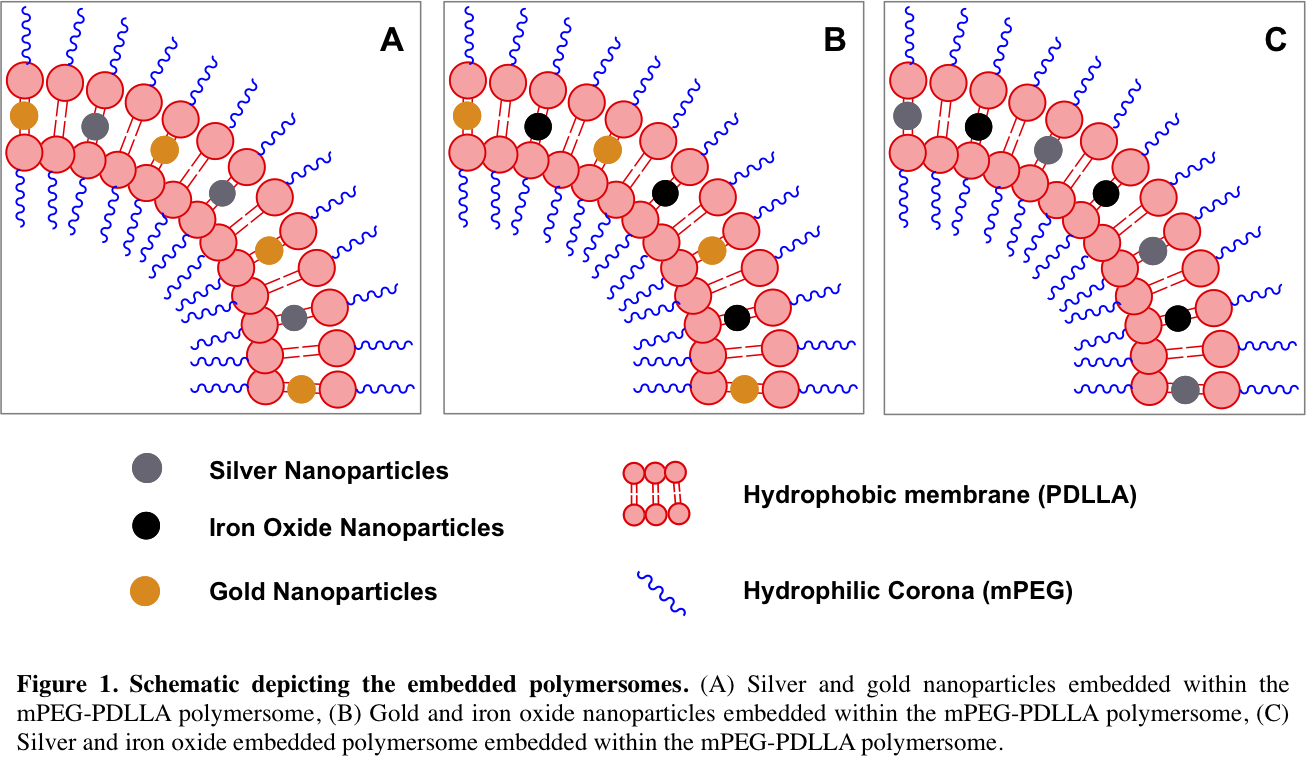Introduction: Polymersomes are synthetic polymer vesicles composed of amphiphilic block copolymers that self assemble to form either a hydrophobic or hydrophilic membrane defined by the copolymer characteristics[1]-[6]. This membrane can be used to encapsulate additional materials such as inorganic nanoparticles that are coated with ligands that have similar polarity to that of the polymersome membrane[7],[8]. Here, we developed a method to encapsulate similarly shaped and sized inorganic nanoparticles such as silver, gold and iron oxide with tunable ratios within the membranes of ~100 nm organic polymersomes to create novel therapeutic and diagnostic materials (Figure 1). These biocompatible hybrid polymersomes can be used for multiple functions including imaging contrast media, radiosensitization and antimicrobial therapeutics[8],[9].

Materials and Methods: An amphiphilic copolymer (mPEG-PDLLA) is used to form 100 nm sized polymersomes, decorated with equal amounts of gold and silver nanoparticles as well as mixed ratios of these nanoparticles embedded within single polymersome membranes. Polymersome size can be controlled by varying the experimental conditions such as the copolymer concentration. The different formulations of polymersomes containing the specific ratios of the inorganic components are analyzed using several chemical, biological and analytical techniques. Mean size distribution and polydispersity index (PDI) of the polymersomes is obtained through dynamic light scattering (DLS). Morphological characterization is measured by transmission electron microscopy (TEM) and cryogenic transmission electron microscopy (cryo-TEM). Cytotoxity of the polymersomes are analyzed against MCF-7 and NIH3T3 using a colorimetric MTT (3-(4,5-dimethylthiazol-2-yl)-2,5-diphenyltetrazolium bromide) assay to quantify mitochondrial activity.
Results: We developed a new method to synthesize monodisperse hybrid polymersomes from an amphiphilic block copolymer with mixed populations of inorganic nanoparticles encapsulated in the hydrophobic membrane. The overall size of the polymersome composites is 100 (± 4.85) nm as confirmed by DLS, TEM and cryo-TEM. Morphological observations through TEM illustrate that the polymersomes have a homogenous and spherical structure (Figure 2). MTT assays reveal that the synthesized polymersomes are nontoxic at doses relevant to the proposed function of each component.

Conclusions: Our results conclude that these theranostic polymersome platforms are employable to treat and track diseases and infections. Radiosensitization capabilities are analyzed through clonogenic assays as well as contrast agent capabilities, which are evaluated through analyzing relaxation time, x-ray absorbance and optical properties.
Volodymyr Kriuchkov; National Science and Engineering Research Council Discovery Grant; Canadian Foundation for Innovation Leaders Opportunity Fund; McGill University Start-up Fund
References:
[1] Lee, J.S. and J. Feijen, Polymersomes for drug delivery: design, formation and characterization. Journal of controlled release, 2012. 161(2): p. 473-483.
[2] Upadhyay, K.K., et al., The in vivo behavior and antitumor activity of doxorubicin-loaded poly (γ-benzyl L-glutamate)-block-hyaluronan polymersomes in Ehrlich ascites tumor-bearing BalB/c mice. Nanomedicine: Nanotechnology, Biology and Medicine, 2012. 8(1): p. 71-80.
[3] Sachsenhofer, R., et al. Polymersome‐Embedded Nanoparticles. in Macromolecular symposia. 2007. Wiley Online Library.
[4] Chiang, W.-H., et al., Functionalized polymersomes with outlayered polyelectrolyte gels for potential tumor-targeted delivery of multimodal therapies and MR imaging. Journal of Controlled Release, 2013. 168(3): p. 280-288.
[5] Discher, D.E. and F. Ahmed, Polymersomes. Annu. Rev. Biomed. Eng., 2006. 8: p. 323-341.
[6] Upadhyay, K.K., et al., The intracellular drug delivery and anti tumor activity of doxorubicin loaded poly (γ-benzyl l-glutamate)-b-hyaluronan polymersomes. Biomaterials, 2010. 31(10): p. 2882-2892.
[7] Robert J. Hickey, J.K., Xin Meng, Robert A. Riggleman, Peijun Zhang, So-Jung Park, Size-Controlled Self-Assembly of Superparamagnetic Polymersomes. ACS Nano, 2014. 8(1).
[8] Geilich, B.M., et al., Silver nanoparticle-embedded polymersome nanocarriers for the treatment of antibiotic-resistant infections. Nanoscale, 2015. 7(8): p. 3511-3519.
[9] Hearnden, V., et al., Diffusion studies of nanometer polymersomes across tissue engineered human oral mucosa. Pharmaceutical research, 2009. 26(7): p. 1718-1728.